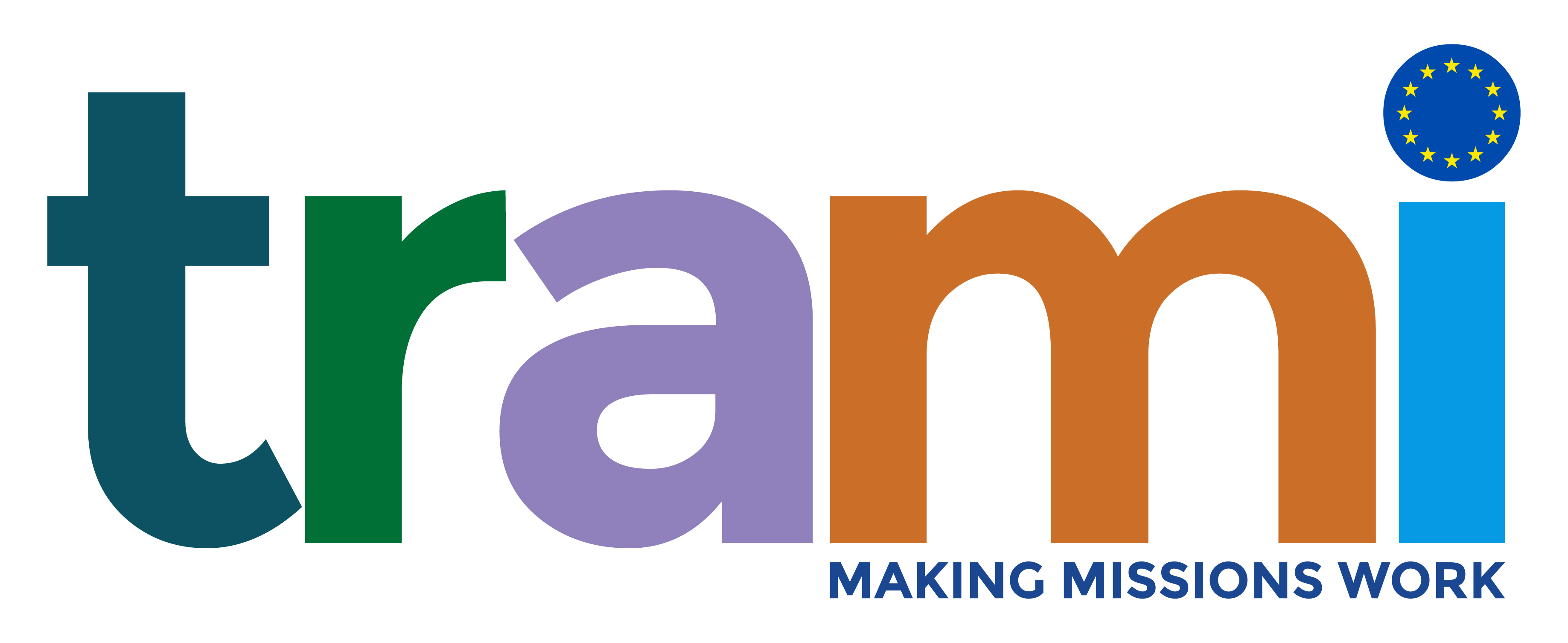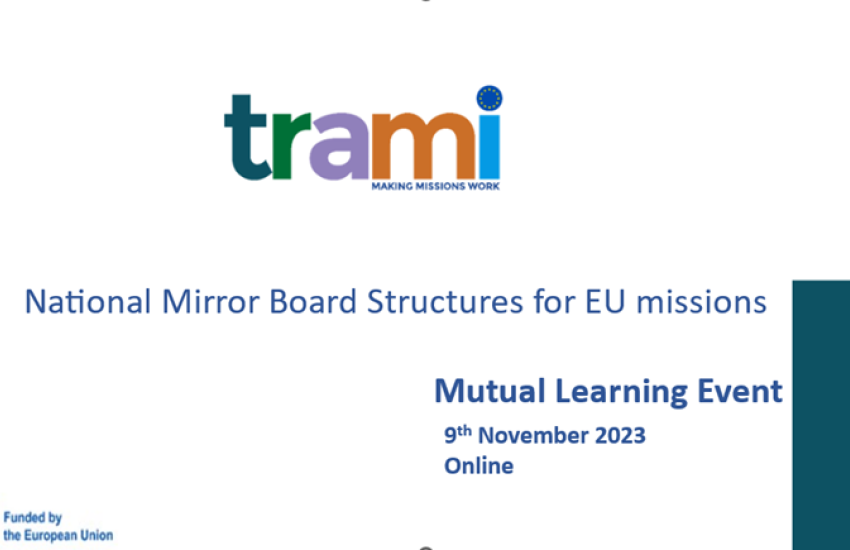Report on the seventh MLE
National Mirror Board Structure for EU missions
ORGANISERS: TRAMI (WP3)
VENUE: Online
DATE: 9th November 2023 10:00 to 12:00
Introduction
TRAMI in conjunction with TRAMI member Enterprise Ireland ran an MLE National Missions Mirror Boards to explore best practices and share knowledge on participants experience. While all the MLEs as part of this work package task are in person, this one was online.
Objectives of event
The objective of the event was to facilitate the development and sharing of good practices and approaches to national mission mirror boards, combined with an opportunity for countries to share their experiences. The event took place online with the aim to be accessible to a broader number of stakeholders from more member states. The target participants are primarily government ministries, stakeholders with responsibility for mission implementation at national, regional land local level and relevant agencies.
Attendees
We had 47 participants registered to attend online, including speakers and organisers representing approx. 15 countries. On the day 37 people attended. While an online event did support the inclusion of people from many countries without the requirement to travel, the downside on the day was that a small number of people left after the presentations. Some people did not take part in the breakout rooms while others returned for the summary and wrap up session. It was a very useful learning point for any future online events.
Methodology
The event was online using MS Teams platform which in addition to the group presentations also facilitated online breakout rooms.
This event similar to the in-person events took the format of presentations and breakout group discussions.
The first presentations focused on the missions and TRAMI project, followed by presentations from two countries.
Presenters
- Gráinne Ryan Enterprise Ireland - overview of TRAMI
- Matthias Weber, Head of Centre for Innovation Systems and Policy at Austrian Institute of Technology presented on Austria’s Mission Boards and Structure.
- Janne Järvinen- Mission Lead, Digitalization at Business Finland presented on Business Finland’s mission boards and industry engagement.
Presentations
- Matthias Weber, Head of Centre for Innovation Systems and Policy at Austrian Institute of Technology presented on Austria’s Mission Boards and Structure. He provided an overview of the Austrian approach. Phase one – 2021 to 2023 focused on preparation and mobilization while Phase two 2023 onwards focuses on the implementation, mobilizing the relevant resources and developing and implementing actions plans and monitoring.
- Janne Järvinen- Mission Lead, Digitalization at Business Finland presented on Business Finland’s mission boards and industry engagement. Provided an overview of the national context of Business Finland’s mission areas, their thematic focus and their digital native mission, which is rethinking digitalisation.
Breakout room discussions - Summary points
Question 1 What do you see as the major benefits / opportunities to having national mission mirror boards?2
The indisputable value of mirror mission boards is to gather everyone, i.e. all the stakeholders under the same umbrella, which means spreading the knowledge, raising the awareness and subsequently creating the sense of ownership among the participants and building momentum.
o The Austrian mission board case study was an example where they managed to set off from research ministry and roll out across administration and across different sectors. Furthermore, the added value is to have the general overarching structure (synergies) and more target-focused action groups. Having such a comprehensive structure enables feeding into the Commission valuable inputs. An administrative approach can streamline matching the European level with regional and local ones.
o In the case study of the Finnish approach presented, it is a great success to have industry committed to the mission – but this may be probably due to mission’s particularity (digital), however it is worthwhile to examine this model in attracting business sector. The fact of being a national mission simplifies the management process.
In some countries national mirror groups are an extension of the existing reference groups for the Horizon Europe clusters e.g., NCPs, as they know the missions. They have a link in to the EC and these reference groups also provide a platform for researchers and universities, however it can be challenging bringing along new stakeholders like cities.
National mirror groups can connect other policy areas, that are not normally connected. They can bring in a diverse group of stakeholders, not just those working with research and innovation. In some countries there can be multiple government ministries involved in mission related issues e.g., the ocean mission here is marine biodiversity and offshore wind power.
Mirror groups can help give more prominence to the missions e.g., cities mission. It provides a national level forum to bring messages to senior civil servants in the relevant government ministries. This new channel of communication can be very helpful in influencing how funding can be used in new ways. The people involved in the cities 100 project can provide hands on advice based on their experience, it is important they have their own voice.
Existing national structure such as a “policy group” for e.g., for cancer, addresses both the cancer mission and also the Beating Cancer Plan. It can provide an opportunity to ensure policy holders are kept up to date in the areas of cancer.
Missions can complement national funding; they can align national and European Initiatives. They can align and possibly combine public funding and private funding. An opportunity to look at new structures where old structures haven’t been delivering.
National mission boards for different missions can have different timelines, the national mission boards also need time to develop.
National government structures of decentralised or centralised government can influence the implementation e.g., communications and funding if the region has its own funding.
Q2 What do you see as the major challenges / obstacles to having national mission mirror boards?
Engaging representations from all stakeholders can be a challenge, e.g. in the cancer mission there are not only citizens but also patients which is rather irregular.
o Diversity apart from being highly appreciated poses also a challenge – not every stakeholder is keen on having every bit of a mission; and there is a clear need to involve the stakeholders meaningfully, not only formally.
In some countries there can be multiple ministries involved in one single mission, all with their own agenda and interests in other countries the ministry responsible for research is the one involved in the missions. A challenge for the national mission mirror boards can be the need for activities to be aligned as there can be bottlenecks and challenges with many different ministries involved e.g., health and the cancer mission, Ocean and climate adaptation.
The lack of one universal model that could be implemented in every MS/AC in every mission. What proves to be working in one country may not translate into another for a variety of reasons, including local / regional government structures, existing groups.
There is a need to involve policy makers however many are already engaged in other national projects and other networks, and it can be a challenge to find time for the missions.
o They need to be involved to address issues such as. what will happen when the EU funding for a specific mission project ends will it be self-sustaining, or will it need national funding?
o Funding the different missions can be an issue for the mission bords, funding in some countries is more centralised than others.
Missions have ambitions that are away from normal research, there is a need for diverse stakeholder group which can be a challenge, people ask what is in it for me. It is also a challenge to see how we can find synergies outside Horizon Europe
In many cases it is the same people working on national level and European level initiatives. Where there are opportunities, national projects can be aligned to the missions in a meaningful way. But it can feel like double work. It can be difficult to translate missions into a real national implementation plan. While there can be good ideas, academics etc. but capacity can be an issue for implementation.
Another potential obstacle is a lack of will and political interest at national level. It is also a challenge how to secure missions’ sustainability in case of a political change after elections. Several countries highlighted that if the government change, the focus on mission can also change. This can complicate the work.
It is crucial not only to have the high level on the same page, but to have the operational level involved, otherwise it may end up with superficial declaration of commitment. The lack of mirror groups, thus the structures at the national level, is a blocker of bringing the regional and local level on board, or at least hinders the process of communication and missions’ implementation. In order to make it functional and efficient one needs to determine the appropriate size of the working group as the greater number of participants may be counter-productive.
- Log in to post comments

